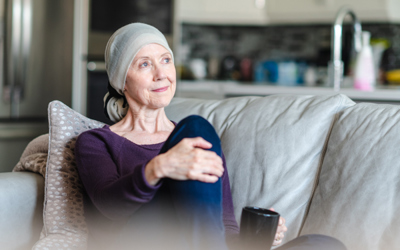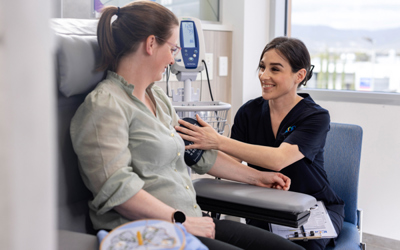What are the treatment options for melanoma?
The primary treatment options for melanoma include surgery, immunotherapy, targeted therapy, radiotherapy and chemotherapy. The type of treatment you receive will depend on a number of different considerations, such as the type of melanoma you have, its stage, your overall health and your treatment preferences. This page aims to give you a comprehensive overview of how melanoma treatment works in the private health system.
Surgery for melanoma
Surgery is a common treatment option for melanoma. For early-stage melanoma, surgery can cure your cancer and reduce the risk of it coming back. Alternatively, surgery can help diagnose how far your cancer may have spread throughout your body.
-
Wide local excision
A wide local excision is a surgical procedure that removes early-stage melanoma tumours and some of the normal skin around it (called a wider margin). The wider margin depends on the size and thickness of the tumour to ensure that no cancer is left behind. This can range from 5mm up to 20mm. While most wide local excisions can be closed with stiches, larger excisions may require a skin flap or skin graft:
Skin flap – Nearby skin is moved over the excision
Skin graft – Skin is taken from another body part and stitched over the excision
Depending on your cancer type and stage, a wide local excision may be the only treatment you need.
-
Sentinel lymph node biopsy
Sometimes, melanoma can spread to surrounding lymph nodes. A sentinel lymph node biopsy aims to find out if cancer has spread to your lymph nodes by removing the first lymph node (known as the sentinel lymph) that the melanoma may have spread to your sentinel lymph node is discovered by injecting a dye and/or radioactive tracker into the tumour and seeing which lymph node it moves to first. This is typically performed when the melanoma is removed. Your care team will examine the sentinel lymph for cancer cells and if no cancer cells are found, further surgery won’t be needed. Alternatively, a sentinel lymph with cancer cells may require a further procedure called a lymph node dissection.
-
Lymph node dissection
A lymph node dissection is performed to remove any lymph nodes near the primary melanoma tumour. Removing all lymph nodes is called a complete lymph node dissection. There are three main areas where lymph nodes are removed. Procedures which focus on these areas include:
Axillary dissection (armpit) – An axillary dissection involves the removal of all lymph nodes from the armpit, including any surrounding tissue that may have cancer cells
Groin dissection – A groin dissection removes all lymph nodes from the groin area and in some cases the pelvis
Neck dissection (cervical lymph node clearance) – A neck dissection involves the removal of all lymph nodes from the neck. This may also include removing a small amount of tissue from the front of the ear (known as the parotid gland)
Radiotherapy for melanoma
Radiotherapy can be used to treat early-stage melanoma without the need for surgery, and to treat melanoma that has come back. In some cases, radiation may also be given after surgery to the lymph nodes or in response to an uncommon type of melanoma called desmoplastic melanoma. It can also relieve symptoms, especially to melanoma that has spread to the brain or bone.
Radiotherapy can be delivered over one to four weeks, depending on the type of melanoma. Types of radiotherapy commonly used for people with melanoma include:
External beam radiotherapy (EBRT)
Stereotactic radiotherapy (SBRT)
Chemotherapy for melanoma
Chemotherapy uses a range of drugs to kill and slow the growth of prostate cancer cells. It may be used to treat prostate cancer which has spread beyond the prostate cancer, and for locally advanced or advanced prostate cancers which have not responded to hormone therapy treatment.
Learn more about chemotherapy and how it is delivered.
Chemotherapy treatment for prostate cancer takes place over several sessions, which is known as a cycle. Your care team will walk you through how many cycles you may need for your course of treatment, with most people completing chemotherapy in a period of three to six months.
Targeted therapy for melanoma
Targeted therapies use drugs to destroy specific proteins in melanoma cells. These drugs effectively treat melanoma with the BRAF mutation, which is found in approximately half of all melanoma cases and causes skin cells to grow abnormally. Other mutations that can be targeted are MEK and C-KIT. Drugs that target the MEK mutation have been shown to be more effective when used in combination with drugs that target the BRAF mutation.
Common targeted therapy drugs that are given in combination include:
Encorafenib and binimetinib
Cobimetinib and vemurafenib
Dabrafenib and trametinib
They are typically given orally as a tablet or capsule and are taken once or twice per day.
Immunotherapy for melanoma
To ensure that the immune system does not attack healthy cells, your cells protect themselves using proteins known as checkpoints. Melanoma cells can attach themselves to checkpoints to hide. Checkpoint inhibitors are drugs that train the immune system to recognise and kill these melanoma cells. They are typically delivered into a vein (intravenously) every two to four weeks for up to two years. Some common immunotherapy drugs include:
Ipilimumab, pembrolizumab and nivolumab – These block the proteins on melanoma cancer cells and boost your immune response
Alternatively, immunotherapy can be offered through a vaccine, known as the Bacille–Calmette–Guerin (BCG) vaccine, or cream. Although the vaccine is not consistently effective in the treatment of melanoma, research continues to refine its use for melanoma treatment.
Clinical trials for melanoma
Icon offers a wide range of clinical trials providing patients with access to new and evolving treatments. Clinical trials offer hope and opportunity and contribute to breakthroughs in treatment for future cancer patients.

Treatment by stage of melanoma
When you are diagnosed with melanoma, your oncologist will develop your treatment plan as part of a multidisciplinary team based on the stage of your cancer.
Common treatment options for each stage of melanoma include:
Stage 0 and stage I melanoma
Surgery to remove the prostate gland (radical prostatectomy), radiation therapy with or without hormone therapy and active surveillance are the most common treatment options for early-stage prostate cancer, alongside cryotherapy. Radiation therapy may involve external beam radiation therapy or brachytherapy. With recent advances in prostate cancer treatment, you may also have the option of focal brachytherapy treatment.
Stage II melanoma
Like stage I melanoma, a wide local excision is the main form of treatment for stage II melanoma followed by a sentinel lymph node biopsy. If cancer cells have been found in the sentinel lymph, a lymph node dissection may be required alongside immunotherapy or targeted therapy.
Stage III melanoma
Treatment for stage III melanoma typically includes a wide local excision and lymph node dissection, which may be followed with immunotherapy or targeted therapy. Radiation therapy may also be delivered to the areas where lymph nodes have been removed.
Stage IV melanoma
If your melanoma has spread to distant parts of the body, your care team may recommend surgery or radiation therapy. Immunotherapy and targeted therapies can also help to shrink melanoma tumours and relieve symptoms, while chemotherapy may be provided if other treatments are ineffective.










